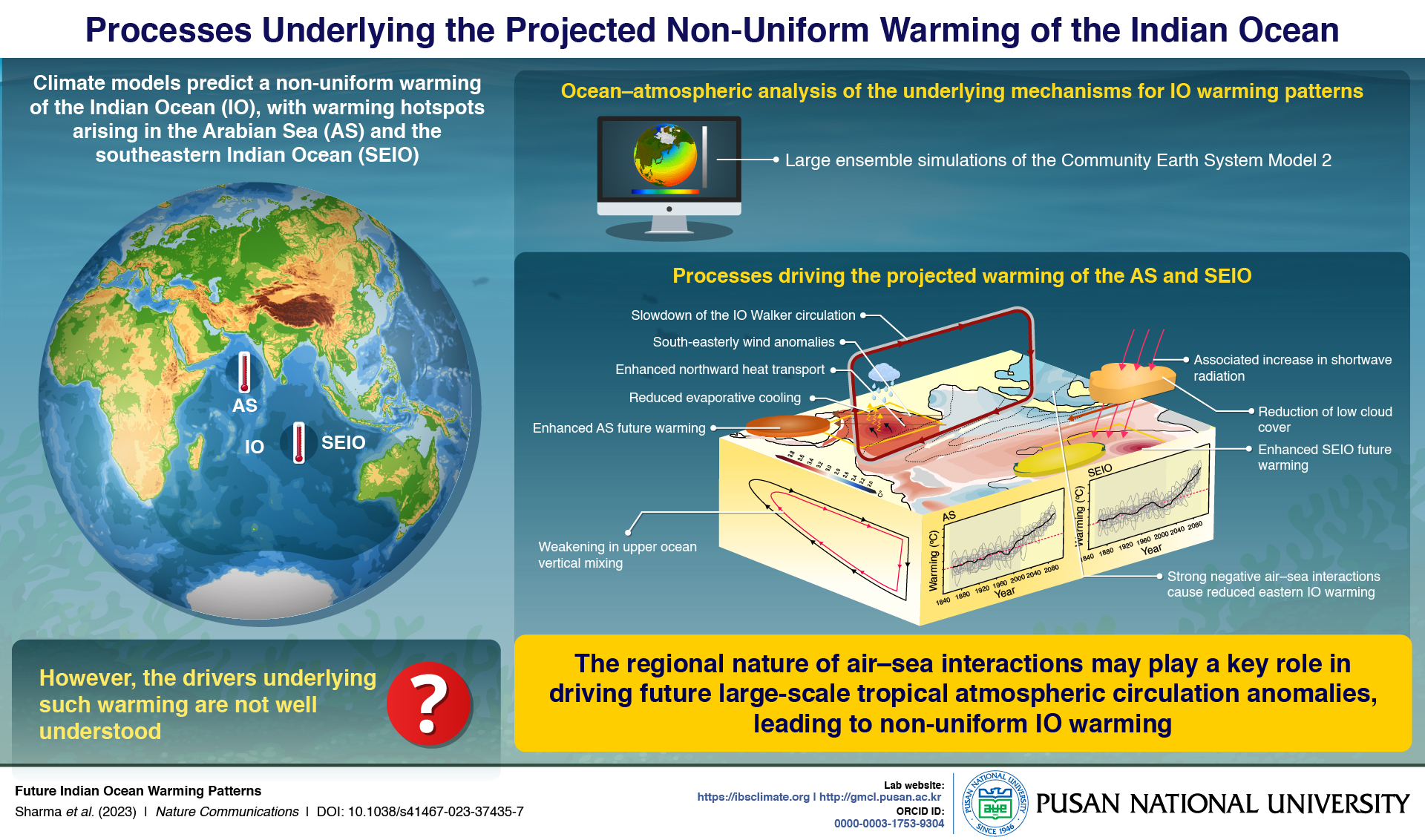Climate models predict a non-uniform warming of the Indian Ocean, with warming hotspots in the Arabian Sea (AS) and the southeastern Indian Ocean (SEIO). In a new study using large ensemble simulations of the Community Earth System Model 2, researchers have found distinct underlying mechanisms controlling such warming patterns. While changes in the ocean circulation patterns would amplify the warming in the AS, reduced low cloud cover-induced heat fluctuations would lead to SEIO warming.

Image title: Factors driving the projected non-uniform warming of the Indian Ocean.
Image caption: Researchers from Korea and Japan have analyzed the projected Indian Ocean warming using large ensemble simulations to identify the underlying physical mechanisms controlling the formation of warming hotspots in the Arabian Sea and southeastern Indian Ocean.
Image credit: Professor Kyung-Ja Ha from Pusan National University, Korea
License type: Original Content
Usage restrictions: Cannot be reused without permission
Newswise — Climate change is a major global concern today. The world is experiencing a drastic increase in temperatures, both over land and oceans. Although this warming is global, some areas are warming faster than others. This temperature variability, especially over oceans, has far-reaching consequences for the wind and weather systems that will affect societies and ecosystems across continents. For instance, the Arctic amplification patterns and the east–west temperature difference in the equatorial Pacific can impact regions far beyond the tropics.
Similarly, changes in sea surface temperatures over the Indian Ocean (IO) could influence climate and rainfall trends across Asia, Africa, and Australia. In fact, IO warming variations can also impact North Atlantic temperature patterns and the Atlantic meridional overturning circulation, an essential component of the global climate system. Many climate projections using coupled general circulation models reveal a non-uniform warming of the IO, with warming hotspots in the Arabian Sea (AS) and the southeastern IO (SEIO). However, there is little understanding of the mechanisms that can lead to such warming patterns and subsequently affect the weather in adjacent land areas.
To bridge this knowledge gap, a team of researchers from Korea and Japan led by Professor Kyung-Ja Ha from Pusan National University (PNU), Korea, has recently investigated the IO warming patterns using large ensemble simulations. In this study, authored by Ph.D. student Sahil Sharma from PNU and published online in Nature Communications on 30 March 2023, the researchers performed an ocean–atmosphere-based analysis using the Community Earth System Model 2 (CESM2), identifying the physical mechanisms underlying the future non-uniform IO warming.
“Instead of running the climate model simulation only once, we performed one hundred simulations on CESM2, which represented the different realizations of the variability in the IO climate system. This new modeling resource has been instrumental in identifying the complex ocean–atmosphere interactions responsible for modulating the IO circulation and warming patterns,” explains Mr. Sharma.
The researchers identified the air–sea interactions in the Eastern IO (EIO)—somewhere near western Indonesia— as a key driver for the warming in the AS. Here, colder deep water upwells to the surface, causing the EIO to be relatively cooler than other IO waters with weak regional warming predicted in the region. This reduced regional EIO warming is also accompanied by enhanced sea-level pressure and strong winds blowing towards the AS, which significantly alter the IO Walker circulation. These changes will cause the warmer tropical waters to move towards the AS, resulting in its warming. In addition, this will induce wetter conditions in the region due to more rainfall and less evaporation, resulting in more stable near-surface-water stratification. This development, in turn, will prevent the upwelling of deeper, cooler waters, further enhancing AS warming.
In contrast, the researchers found that the projected warming in the SEIO will be amplified by a reduction in the total low cloud cover over the region, resulting in more shortwave radiation hitting the ocean surface and causing it to warm. Therefore, the drivers for the future warming hotspots in the AS and the SEIO are quite distinct from each other, with ocean circulations modulating the former and cloud-induced heat fluxes controlling the latter phenomenon.
Based on these results, the researchers concluded that regional air–sea interactions can trigger large-scale variations in atmospheric circulations with widespread impacts even in regions outside the IO. Highlighting the implications of the present findings, Prof. Ha says: “Unless carbon dioxide emissions are drastically reduced, global warming will continue to enhance the warming in the AS with dire consequences for regional climate, marine biogeochemistry, and the African and Indian monsoon systems. This research could facilitate better marine resource management and information dissemination to fisheries and also guide future research on the effect of the projected non-uniform IO warming on regional rainfall patterns.”
We certainly hope her vision is realized soon!
Reference
Title of original paper: Future Indian Ocean Warming Patterns
Journal: Nature Communications
DOI: 10.1038/s41467-023-37435-7
About the institute
Pusan National University, located in Busan, South Korea, was founded in 1946 and is now the No. 1 national university of South Korea in research and educational competency. The multi-campus university also has other smaller campuses in Yangsan, Miryang, and Ami. The university prides itself on the principles of truth, freedom, and service, and has approximately 30,000 students, 1200 professors, and 750 faculty members. The university is composed of 14 colleges (schools) and one independent division, with 103 departments in all.
Website: https://www.pusan.ac.kr/eng/Main.do
About the author
Professor Kyung-Ja Ha is a climatic extreme and monsoon hydrology expert at Pusan National University. She joined the Department of Atmospheric Sciences as a faculty member in 1994. Her research group has been leading the research on monsoon dynamics, climate physics, and boundary layer physics. She has also been working at the IBS Center for Climate Physics (ICCP) with Prof. Axel Timmermann (director of ICCP) as an Affiliated Professor since 2017. She conducted the current research with Sahil Sharma, a Ph.D. student (ICCP), who is the first author of the study and is specializing in Indian Ocean dynamics.